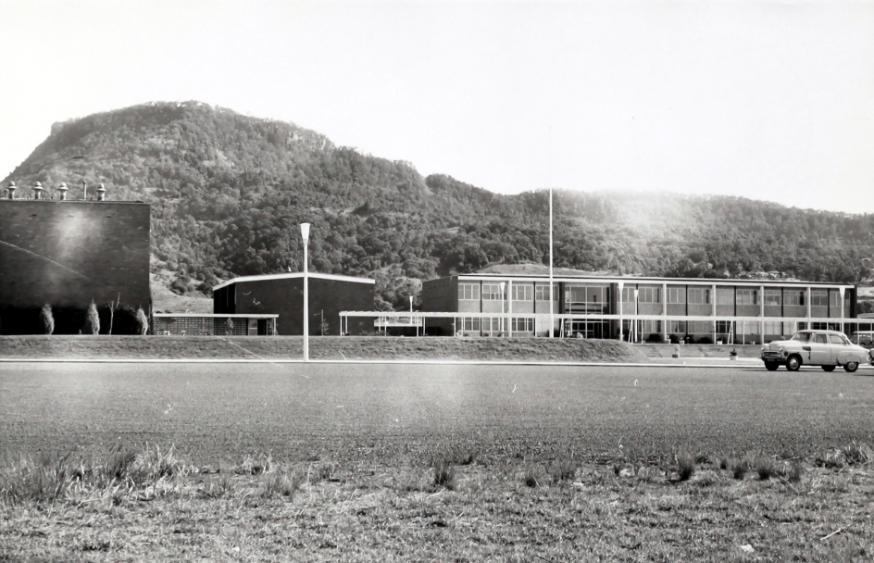November 16, 2019
UOW’s economic impact a ‘beautiful thing’
Professor Alex Frino reflects on the economic growth of UOW since the first slab of concrete was laid in the 1960s.
My father – like many good Italian migrants – was a concrete finisher by trade.
In the early 1960s he was sent to a patch of farmland on the edge of Keiraville to lay slab for a large new building. It was in the middle of nowhere, and my dad says he asked the leading hand at the time “what are we doing here?”
The response was “we are laying the foundations of a new university”. Not quite right – at the time the building was to become part of the Wollongong College of the University of NSW, and the first students arrived at the Keiraville campus in 1962.
By 1975 the University of Wollongong separated from the University of NSW. That building is now known as Building 1 at UOW, and the slab is still there!
I finished my undergraduate degree at UOW 30 years ago to this very day! Back then, the University was barely 10 years old and what you saw was what you got. All its activities took place on Northfields Avenue and it had barely 10,000 students. I guess the annual budget was no more than about $100 million or so.
We didn’t offer medicine or law and there were few international students sitting in classrooms.
The biggest employer in the region was the Port Kembla steelworks which employed more than 20,000 people, and the second largest was no doubt the coal mines.
I was absent from the University, and in truth the region, for almost 30 years up until three years ago. On my return, I was staggered by what I saw. The number or students enrolled at UOW, according to the statistics published by the Department of Education, has grown to around 35,000 making it the nineteenth largest university in the country. The same statistics reveal that almost 8000 are international students bringing new ideas, culture, money and blood to the region.
My good colleague, UOW Chief financial Officer Damien Israel, like any good accountant puts enormous effort into preparing the “apple pie” accounts of the University which are now published in a 150-page plus document.
If you would care to read those accounts in your spare time, they demonstrate that the annual budget – what UOW spends in the Illawarra – has grown to around $800 million and is fast approaching the $1 billion mark. The University employs almost 3000 people – half of whom are academics and the other half administrators, tradespeople, security, grounds staff and everything else you can imagine. The University is, without a doubt, the biggest game in town – with only Bluescope Steel and South32, who now employ less than 3000 people, coming a close second or third.
The University commissions a regular economic impact study. According to the latest, UOW’s contribution to the region is in the order of $2 billion in gross domestic product. That is something like 10-15 percent of the region’s total gross product.
While these numbers are impressive, the University has another major strength and contribution to make. I notice that the University of NSW up the road brags that it is “Australia’s Global University” in its mission statement. But that’s not exactly correct.
Around 25 years ago UOW decided to go global and became the first foreign university in Dubai. It is now one of the largest foreign universities there. We wave the Wollongong brand so well in the United Arab Emirates that they named a beach after us - Wollongong Beach in Dubai.
UOW has expanded to create campuses with operations in Malaysia, Singapore and Hong Kong. Late last year, UOW made big news in Malaysia, when the Malaysian Stock Exchange released an announcement that one of its listed companies, Paramount, had sold one of its major assets, KDU Colleges, to UOW for 38.5 million Ringitt (approximately $A13.6 million). UOW continues to wave the Wollongong flag, and to uniquely carry the name of this city in many important international destinations.
According to DETYA, and if you include the students enrolled at its new campus in Malaysia - which is about to be inaugurated this week with the name UOW Malaysia – UOW has almost 14,000 students enrolled offshore. This makes it, roughly, the Australian university with the largest offshore presence.
UOW is promoting the region and Australia in important offshore markets, which can help generate future economic growth and export for the region.
But perhaps one of the most interesting points to be made, is that unlike Bluescope Steel and South 32 – the University has always been and remains a not-for-profit organization which is roughly break-even and spends the majority of what it generates in the region.
It’s getting to that time of year when we reflect on what has gone on over the last 12 months. I hope you will forgive me for indulging (a little) in this economic commentary on the University and for using the cliché “it’s a beautiful thing”.
Alex Frino is Professor of Economics and Deputy Vice-Chancellor (Global Strategy) at the University of Wollongong.
UOW academics exercise academic freedom by providing expert commentary, opinion and analysis on a range of ongoing social issues and current affairs. This expert commentary reflects the views of those individual academics and does not necessarily reflect the views or policy positions of the University of Wollongong.
